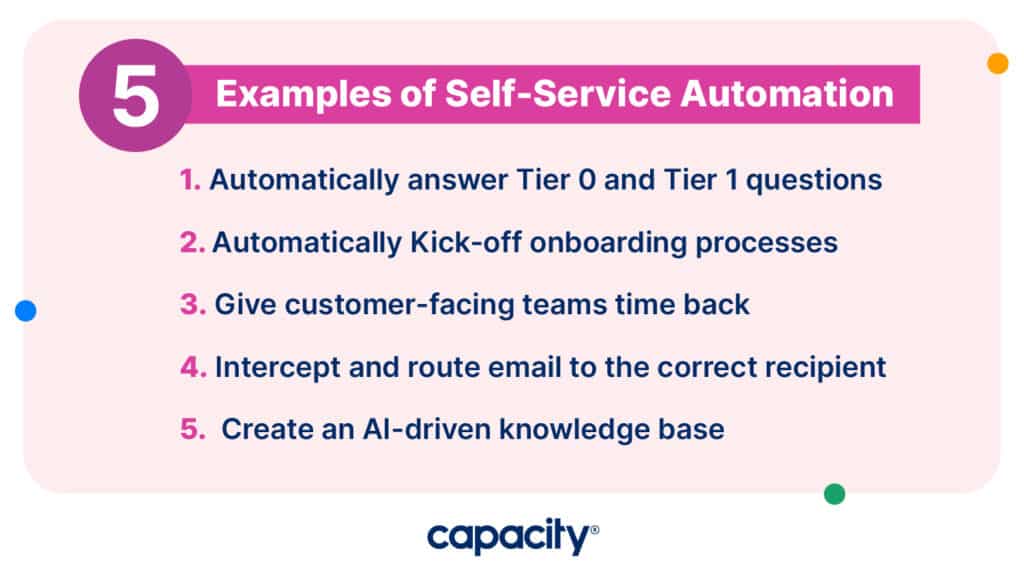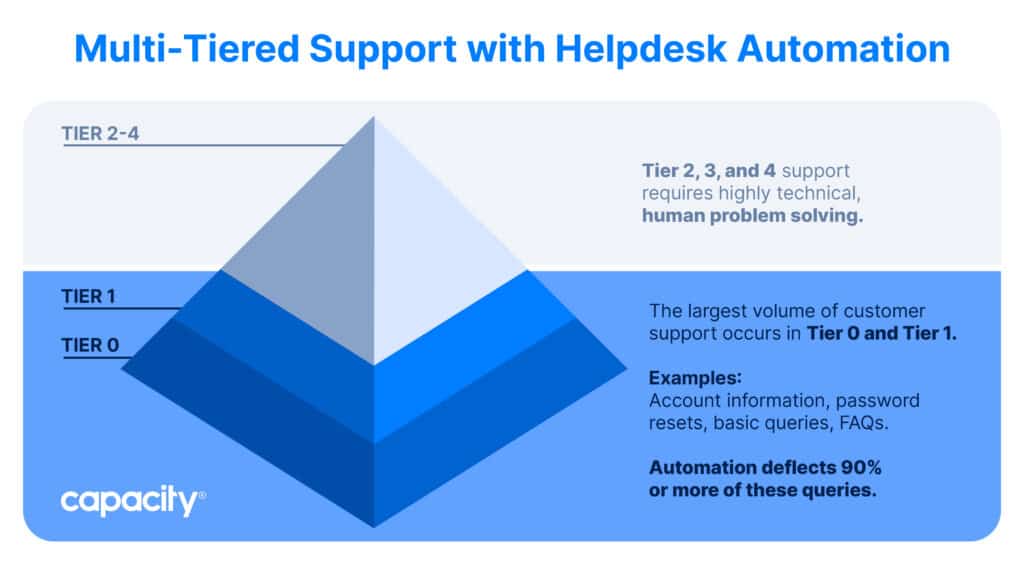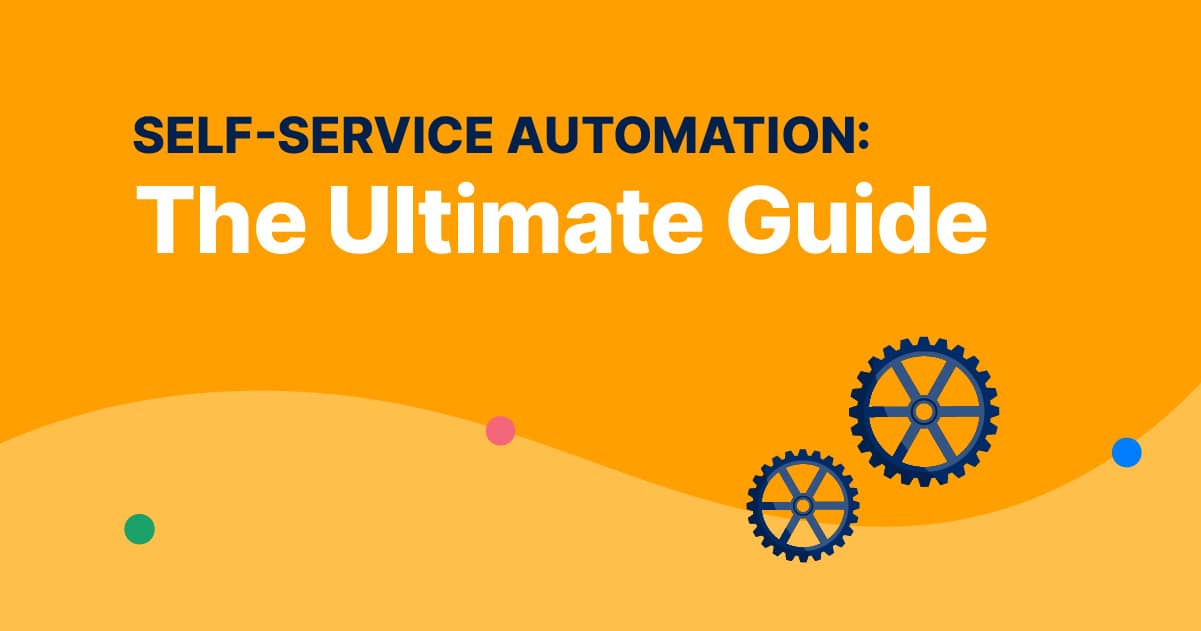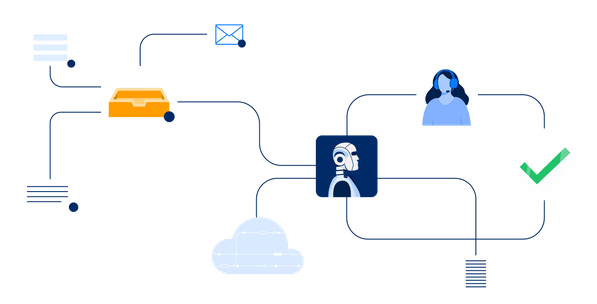What is self-service automation?
Self-service automation empowers business users and customer-facing help desk teams to automate requests or support tickets traditionally handled by customer service or IT teams. Self-service automation enables individuals to access and use IT services quickly, conveniently, and securely.
How can businesses use self-service automation?
Self-service automation can be used in various ways, from automating routine tasks such as password resetting or account creation to more complex jobs like data analysis or customer service operations. With self-service automation, businesses can increase the efficiency of their customer service operations, reduce the workload on IT teams, and provide customers with a better user experience.

5 examples of self-service
Self-service automation is becoming increasingly popular in many industries, allowing businesses to automate manual tasks and eliminate time-consuming processes. Examples of self-service automations include automating customer service requests, employee onboarding, etc. By leveraging the right tools and resources, businesses can reduce costs while increasing organizational efficiency.
Take a deeper dive into some key self-service examples:
1. Automatically answer Tier 0 and Tier 1 questions:
Automating customer service requests through self-service automation can be an effective way for businesses to reduce their workload and improve the user experience. By implementing self-service automation, help desk teams can quickly and easily answer common questions like password resets or account creation requests without contacting IT teams.

2. Automatically Kick-off onboarding processes:
The onboarding process can be a time-consuming and tedious task for any organization. With self-service automation, businesses can quickly initiate the onboarding process for new employees. Automation tools can automatically gather required documents from new hires, provide access to online training materials or employee handbooks, and even generate welcome emails. Automatically onboarding new employees can make the process more efficient and reduce the workload on IT teams.

3. Give customer-facing teams time back:
By utilizing self-service automation, customer service teams can become more productive and efficient. With help desk automation tools at their disposal, they won’t have to devote as much time manually responding to inquiries; instead, they’ll be able to focus on complex tasks such as data analysis or operations. Moreover, customers will receive real-time answers to their questions – freeing up even more valuable time! It’s a win-win situation that enhances the company’s efficiency while providing better service for your customers.
4. Intercept emails before they reach teams:
Email can be one of the most challenging customer service tasks to manage. With self-service automation, businesses can streamline the email process by automatically answering repetitive emails or tickets with AI. Automation tools scan incoming emails and use your existing company knowledge to generate responses, before an employee is distracted. This will ensure timely responses to customer inquiries and make it easier for customer service teams to manage large volumes of emails.
5. Create an AI-driven knowledge base:
An AI-driven knowledge base is a great way to use self-service automation to answer customer inquiries. Knowledge bases allow customers to search for answers by themselves quickly, and with AI-powered technology, businesses can create comprehensive databases that are constantly updated and improved. This type of self-service automation reduces the time customer service teams need to spend helping customers find the answers they need.
Why is self-service so important?
IT departments, like service desk teams, are very busy. This is because a lot of data, processes and digital tools need to be managed daily. But even though IT teams have more to do, they sometimes get little money or time to do it.
To ensure that IT operations meet service level agreements and drive digital transformation initiatives, personnel must cut down the duration of manual, repetitive processes. Self-service technology is a powerful tool to decrease the number of day-to-day business requests requiring responses from IT departments.
As organizations become increasingly tech-driven, their daily operations depend on IT services. Unfortunately, IT can no longer keep up with the growing business demands in a streamlined fashion.
Business teams are often left in limbo, waiting for IT to reset passwords or run reports, hindering their performance. By allowing business partners access to self-service automation tools, however, we can avoid these delays while enhancing customer service and lessening the workload of IT personnel.
The importance of security and compliance in self-service
We have seen the onslaught of tech companies blindly adding Chat-GPT into their existing applications at warp speed. Capacity uses a secure LLM to generate responses, without risking our customers’ (or their customers’) data. Any companies looking to add an AI tool to their tech stack should be sure to vet their vendors and check that they use recommended data security practices.

3 checks for security and compliance in self-service environments
Vet your vendor: As always, we have taken the necessary steps to ensure that our self-service tools are secured within a secure environment and encrypted for maximum security. We also employ compliance standards, such as GDPR, HIPAA, and SOC 2, to ensure all data is collected safely and ethically.
Leave it to IT or Ops: IT should always remain responsible for granting user permissions to teams and individuals, ensuring secure access to confidential operational procedures and systems. Most self-service portals don’t provide the capability for non-IT personnel to build or revise automated processes, safeguarding against unauthorized changes.
Make sure it does the job: Self-service automation relieves stress for business teams. Not only is it essential that the platform you select works with your existing systems but it also guarantees compliance and security auditing. For this reason, IT teams and decision-makers should be familiar with the exact self-service platform they choose – because efficient implementation will result in streamlined operations while ensuring all legal requirements are met.
Self-Service best practices
Implementing a self-service automation portal can be tricky. However, following the proper best practices will help your team reduce IT tickets and encourage users to use them. After all, people are far more inclined to use easy access and convenience solutions – making their lives easier!
- Seek insightful feedback to comprehend better what business users expect to achieve with an autonomous tool. Leverage surveys or focus groups to determine which processes could benefit your business most.
- Examine the regular service requests sent to IT Service Management (ITSM) or service desk teams. Routine, manual tasks present an excellent opportunity to use self-service to reduce requests requiring IT staff attention.
- Secure enthusiastic support from business teams by engaging with their leaders and revealing the advantages that self-service automation can bring them. Raise understanding of the self-service portal by exhibiting success stories and forming alliances with business partners to construct internal communication strategies.
- Devise a comprehensive internal unveiling plan for your self-service automation portal, and urge business users to suggest improvements and comment on pre-existing options.
Self-service automation is a good thing for IT and business teams. It gives people the tools they need to work quickly and smartly. Using this technology will help your IT and customer support teams by giving better service and more power to your internal staff. Organizations that use self-service automation typically result in happier, more productive, and loyal teams.
Self-service: the bottom line
With the right self-service automation solutions in place, you can ensure that business teams have access to the tools they need to do their jobs quickly and efficiently.






